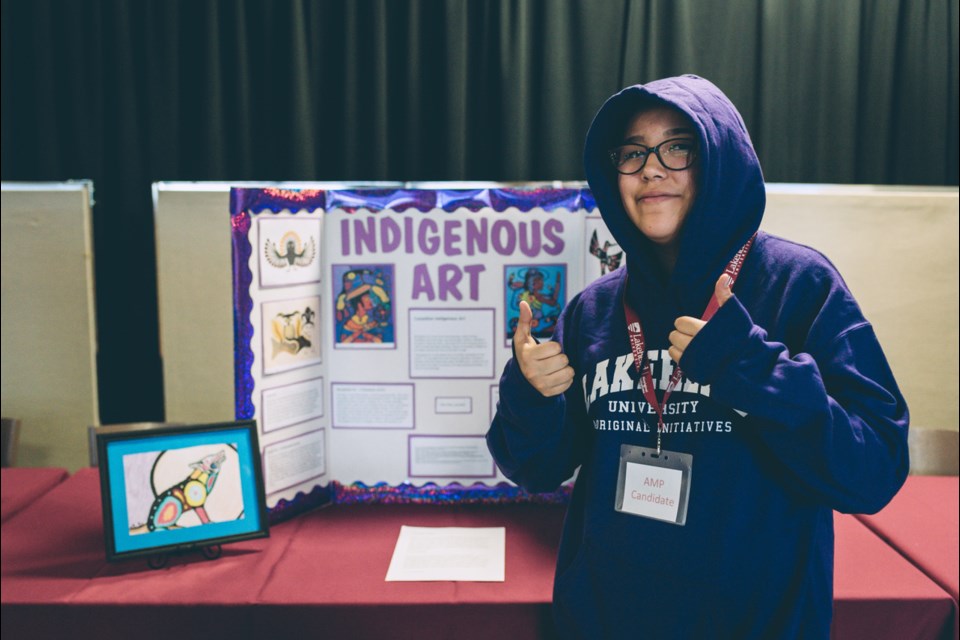Discovering the ins-and-outs of a post-secondary education is a struggle everyone experiences. The new development of an adult life, leaving an adolescent friend group and discovering the growing opportunities; it’s a period of awaiting transitions no one is prepared to encounter.
The Aboriginal Mentorship Program has been designed to curve those anxieties.
The AMP has been active since 2013 and Lisa Harris, the program coordinator, has been there since the beginning.
That first year, they worked with 40 kids. After its first year, “it exploded very quickly,” Harris said.
The mission of the AMP is to demonstrate to every Indigenous high school student that post-secondary school is attainable, and that there are many different pathways to get there.
Laila Doblej is a former AMP youth and now university student in the nursing program. “I knew from a young age what I wanted to pursue for my career [and] AMP played a huge role in helping me figure out how to get there.”
The program visits regional school classrooms to conduct a multitude of activities, experiments, and motivational challenges. The high schools include, Westgate Collegiate & Vocational Institute, St. Patrick High School, St. Ignatius High School, and Superior Collegiate & Vocational Institute.
Post-secondary promise
The program matches university students with Indigenous high school students to create a positive connection. This connection both inspires and assists students in thinking about their future through cultural sensitivity and non-judgmental honesty.
AMP starts the year by getting university students of all backgrounds and ethnicities to be the mentors.
Tessa Casella just completed her Certificate in Indigenous Learning and was a mentor with AMP.
“As a mentor I would work alongside the students answering questions and offering guidance while assisting them with the task at hand," Casella said.
Once in the high school, a hands-on-activity is always on the docket to engage learners. These activities range from painting rocks while learning about hieroglyphics, identifying stone and mineral density and making tiny electric cars while learning about energy sources. Even bath bombs are an experiment the youth explore.
Forward thinking
Kids are engrained to feel a pressure in school, the constant guidance above them, and AMP gives them an opportunity to settle in and discover what interests them. It's a different way of learning than the typical classroom.
The program works diligently to show Indigenous youth that they have a place in post-secondary education. By giving relevance to Indigenous content in often Eurocentric subjects, students are made aware of their cultural significance.
“We want it to be fun and a safe place to be; like they’re learning but not make it feel like they’re learning,” Harris said.
A funded foundation
Harris said AMP’s biggest setback is funding to have enough staff, material and travel money. “It’s not a one-person job anymore.”
AMP looks for grants and funding from corporations. Three years-ago they received a $1 million endowment fund from the Joyce Family, the biggest contribution to date.
Included in this funding is the supply of snacks and drinks. Sometimes, this is the most important factor for the kid’s involvement and Doblej was one of those kids.
“In high school I always struggled with having adequate lunches to get through the day, AMP always provided nutritional and cultural foods to us," Doblej said.
Even though funding is always a constant need, their biggest success is the volunteers. “We couldn’t run the program without them,” Harris added.
They have engineering and nursing student’s part of the volunteer program who can speak to a specific degree. This helps with the goal of pushing kids toward a post-secondary education in a more serious and specific way.
A name change for success
Going forward, the Aboriginal Mentorship Program is changing the words associated with the path of leadership. Beginning this month, their name will be changed to Niijii Indigenous Mentorship.
Niijii means ‘friends.’ Harris said they wanted to use the term for two reasons; it is a very similar word in both Ojibway and Cree and because it is the way they try to run the mentorship program.
“We all learn from one another and we treat one another with love and respect," Harris said. "The youth teach the mentors as much as the mentors teach the youth.”
With a name change and the defined success that makes the AMP what it is, the future is nothing but bright.
Even though COVID-19 has brought interruptions in the regularly scheduled program, AMP will continue supplying the support needed for Indigenous youth, and with a name change, the Niijii Indigenous Mentorship will be nothing but rewarding.



